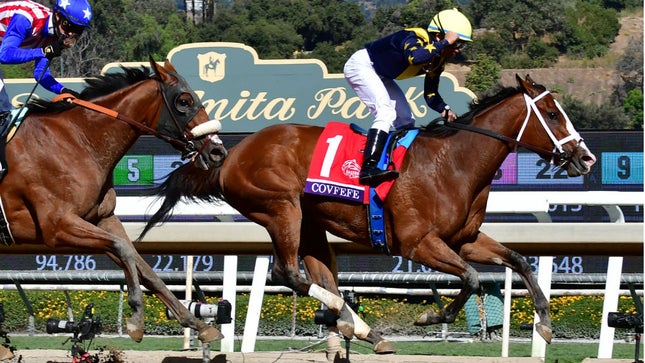
Late on Thursday, February 27, the California Horse Racing Board sent out a notice to horsemen that shook up trainers on the backstretch at Santa Anita Park, Golden Gate Fields, and Los Alamitos.
The emergency regulatory amendment prohibits the use of non-steroidal anti-inflammatories, phenylbutazone, flunixin, ketoprofen, electrolyte solutions, and amino acid solutions starting at midnight the night after a horse has been entered. Some substances, such as Lasix and injectable vitamins, will still be permitted.
The original memo sent to horsemen stated that the new rules would go into effect February 26 (the day after the memo was distributed), but a clarification on the ruling was distributed February 28, noting that the changes will go into effect March 1.
Acceptable medications include topical ones (ointments, hoof dressings, and leg paints), anti-ulcer medication, and tetanus antitoxin if the horse injures itself. Lasix is the only medication that can be given within 24 hours of the actual race.
The lack of ability to give electrolyte solutions has caused a stir, with trainer Eoin Harty, president of the California Thoroughbred Trainers, asking for a 30-day moratorium on implementation. He gave an example of a horse shipping between Northern and Southern California to race in the summer, and not being able to receive electrolytes after arriving from the grueling van trip.
Racing manager and bloodstock guru David Meah took to Twitter to express his disapproval, tweeting that the rule is “stupid” and that it “hurts horses not helps them.” But in an article posted on Bloodhorse.com, the CHRB’s medical director, Dr. Rick Arthur, was quoted as saying, “I don’t think it eliminates the ability to use electrolytes; it just doesn’t specifically allow them.”
The CHRB did give plenty of notice about the changes, first adopting them at their board meeting on January 22. The emergency regulatory action expires on August 25.
These rule changes come after Santa Anita has made an aggressive attempt to lure horses back into the state of California. The track is launching a new cash bonus for owners of horses who have raced at the current meeting. They will receive a ten percent bonus on purses earned between March 6 and June 21. Another program that starts April 1 pays a 50 percent bonus to any owner whose horse finishes first through fifth in their first start of the meet (first time starters and stakes runners are ineligible).
The changes also come two days after Oaklawn Park announced another series of purse hikes, with purses increasing by $1,000 – $4,000 depending on class. Oaklawn has been steadily raising purses over the last few years, making that meet incredibly lucrative for horsemen.
Medication changes are no surprise in racing, but the jurisdictions seldom work together to produce a unified product. Also on February 27, Churchill Downs and Keeneland announced that they will ban Lasix for two-year-olds in 2020.


